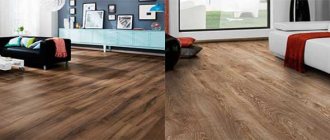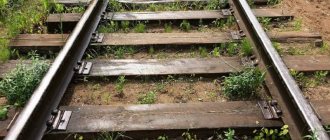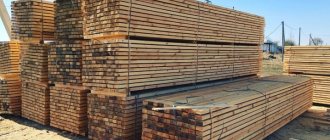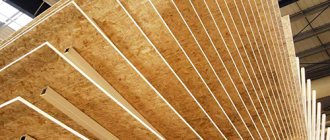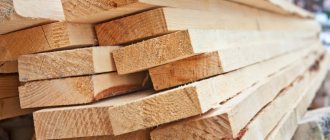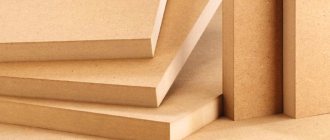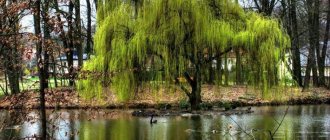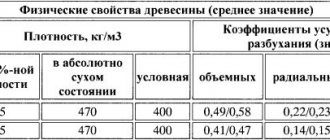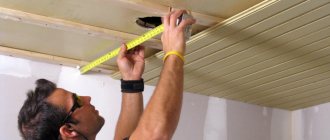Even at the beginning of the last century, this type of cladding, such as lining, was not known to anyone. Only after the widespread use of freight cars lined with this type of finishing did people learn about this method. And people began to massively use this profile to decorate and protect their homes. But in order for this coating to look beautiful and please the eye, high-quality installation is required. In order to achieve this, you need high-quality lining, the exact dimensions of which will be indicated in the table. Choosing such a coating is a very responsible step, but if you follow all the rules, the result will stun you.
Dimensions and other GOST standards of wooden profiles
Eurolining and domestic ones have a number of differences. For example, domestic panels do not have GOST, which is actively used by unscrupulous manufacturers, sometimes independently selecting the dimensions of finished products. Nowadays you can find different sizes on the market, for example:
- Thickness - from 1.2 to 4 cm;
- Width - from 7.5 to 20 cm;
- Spike size - from 0.4 to 0.5 cm;
- Length - from 20 to 600 cm;
And although errors are not included in the finished material, such defects are still quite common.
Eurolining has more specific parameters; when choosing such a profile, there is a limited variation in sizes:
- Thickness - 1.3; 1.6; 1.9 cm respectively;
- Width - 8, 10, 11, 12 cm;
- Length varies - from 50 to 600 cm;
- Spike - from 0.8 to 0.9 cm.
Errors are strictly regulated and can vary within the following limits: width - 0.7 cm, length - 0.5 cm, thickness - 0.1 cm, spike - no more than 0.1 cm.
Wooden profiles are made from different species. Most often, certain varieties are used to make panels, such as oak, alder, linden and aspen; these are deciduous; coniferous species are usually represented by cedar, larch and pine. The final price of your coating largely depends on the material you choose.
In order not to pay extra money, you should very carefully calculate the required amount of material. Here are several wood options, their parameters and characteristics.
Oak - as a rule, is used for cladding residential premises; it has a natural, beautiful appearance. Unlike other species, oak lining is very durable, although it is many times heavier; finishing with such material will last a long time due to its wear resistance. Oak profile parameters: width - from 5 to 10.8 cm (depending on the manufacturer), length - from 100 to 300 cm (the most common are 300 cm, 270 cm, 250 cm, 180 cm), thickness varies from 1.25 cm up to 1.5 cm (often 1.4 cm).
Aspen - panels made from this type of wood are used for interior decoration; special preference is given to this material when lining steam rooms and baths. There is material on the market from both foreign and domestic manufacturers. For samples of foreign products there are increased requirements for the quality of raw materials, as well as for humidity and size. For this reason, the imported profile is several orders of magnitude more expensive and complies with the European standard DIN 68126.
Our manufacturers do not comply with this standard, but often use GOST, in which the quality is significantly lower than in the European standard. But both foreign and our manufacturers use the following dimensions: total width - 9.6 cm, working width of the lining is 8.8 cm, length - from 100 to 300 cm, and thickness - from 1.25 cm to 1.5 cm (European standard - 1.25 cm).
Pine is the most popular and versatile type of coating; it is used more often than other types in interior decoration. This is mainly due to affordability and ease of processing. Such panels also have their own limits in size: width - from 5 to 10.8 cm, length - from 50 to 300 cm (200-300 cm is more common), thickness - from 1.25 to 1.5 cm (more often than usual - 1.25 cm or 1.3 cm).
GOST and DIN: what is it, how do they differ
Modern production of lining is strictly regulated by two standards: GOST and DIN.
The first is the domestic standard of quality, the second is German. The panels are sorted before being sold. The domestic manufacturer offers three grades: 1, 2, 3, where 1 is the highest, 3 is the lowest. According to the European standard, varieties Extra, A, B, C are distinguished.
Extra features a perfectly flat and smooth surface without knots, cracks, or flaws. The color of the panels is uniform, without differences. Further, depending on the number of defects, the quality of the lining becomes lower.
A little about the sizes of MDF profiles
MDF panels have recently gained popularity for interior decoration. Due to the low price and environmental friendliness, consumers are often inclined to choose just such a coating.
It is produced by pressing wood chips, gluing is done with lignin.
The main difference from a wooden profile is the size and shape of MDF products. Thanks to its low weight, it can be quickly and easily installed anywhere. It is used for finishing walls, ceilings, as well as loggias and balconies. Due to its environmental friendliness, it is often used even in bedrooms. Unlike wood products, MDF panels differ significantly in size: width - from 10 to 25 cm, length - from 100 to 300 cm, thickness - 0.55 cm to 0.7 cm.
Products made from such material do not tolerate high humidity well, for this reason you should not use it in baths, steam rooms, saunas and toilets.
Deciduous trees
Hardwoods are used for the manufacture of lining somewhat less frequently. Mainly birch, ash and aspen are used here.
- Birch. Almost all types and profiles of lumber are made from birch. It has a high density, is easy to process and holds the varnish coating well. The main disadvantage of the material is its strong susceptibility to rotting.
- Ash. This breed is mainly used in furniture production. However, it can be used for the manufacture of lining. This tree has a beautiful texture and almost does not warp. And resistance to decay and high strength make ash one of the most valuable species. Used for interior decoration of houses.
- Oak. The most durable, rot-resistant rock. It has a high cost, which is why it is used relatively rarely.
- Aspen. There are also boards made of aspen. It has soft wood with a porous structure. This material is easy to process and has a long service life. There are almost no knots in it. Aspen is the best option for finishing a steam room.
- Linden. This lining is used for finishing baths and, in rare cases, for cladding a house. It has the widest range of colors possible: from light brown to almost white. Linden is durable, not afraid of rodents and moisture. Under the influence of high temperatures, it may change color over time (restored after sanding).
All types of wooden lining are mounted on the sheathing. Fastening can be done using clamps or Volna fasteners (whatever lining is used, it is not recommended to mount it using only nails or self-tapping screws).
PVC lining and its dimensions
The most budget option is panels made of PVC. Due to the fact that this material is indifferent to moisture, its use is versatile. Used for finishing steam rooms, baths, bathrooms, as well as outside and inside.
A significant disadvantage of this coating is increased fragility, especially in cold weather; for this reason, when used outside, it makes sense to cover areas inaccessible to mechanical impact.
PVC profiles are produced in two types, thick - 0.8-1 cm and thin - 0.5 cm. With a panel width of 10 cm, the length, as a rule, corresponds to 300 cm. If the lining is wide - 20-37 cm, then its the length will be 260 cm, 270 cm and 300 cm respectively. PVC panel standards: width - from 10 to 50 cm (yes, such widths exist), length - 260, 270, 300 and 600 cm, respectively, thickness - from 0.5 cm to 0.8-1 cm.
Area calculation
The sequence for calculating the area of the surface to be covered is best calculated using the example of a house measuring 6x10, where the ceiling and walls will be sheathed.
Then we calculate the quadrature of the first room. Let's say the length is 6 m, width - 5 and height - 2.5 meters.
Then everything is extremely simple, as taught in school:
- Long side - multiply the height by the length 6x2.5 = 15 m2;
- The wall opposite has the same dimensions, for this reason we multiply the result by two 15x2 = 30 m2;
- Using the same principle, we calculate the square footage of the wall, which is smaller than 5x2.5 = 12.5 m2, multiplying the resulting result again by two 12.5x2 = 23 m2;
- To calculate the ceiling area, multiply the width by the length of the room 5x6 = 30 m2;
- We add up the data obtained and get the coverage area of this room 30+23+30=83 m2;
In the same way, we calculate the area of the remaining rooms, add the result together, and we will know the total quadrature of the entire surface.
We calculate the square footage of the balcony in the same way, except that in this case it is most convenient to divide each side into its constituent figures.
Calculation of required material
In order for us to correctly calculate the required quantity, we must know the dimensions of the panels. The size of the lining is not a mandatory standard, and this indicator has a wide range.
In accordance with GOST, the thickness of a standard board can vary from 1.2 to 2.5 cm, the average width is 15 cm, and the length is within 600 cm.
The profile for interior work is used with a thickness of no more than 1.6 cm, while the lining with a thickness of 1.8 cm is used for external covering.
Having the length and width values available, we can easily calculate the required area. Here's an example: let's say the length of the panel is 500 cm and the width is 15 cm, then the total quadrature of the profile will be 0.75 m2.
When calculating the required quantity, it should be taken into account that the width of the profile during installation will be less than the total width of each panel, due to the peculiarities of the fastening - tongue and groove.
Well, as a last resort, in any hardware store there is a consultant who will help, using a special calculator, calculate the required amount of material.
How to decipher the manufacturer's inscription
We read the marking as follows:
- Sheathing brand (see details below)
- Type of lining (see table below)
- ThicknessxWidthxLength
- GOST
- Sometimes manufacturers indicate the number of pieces per package
An example of a symbol for eurolining:
Grade C 12.5×96(88)x2000 mm 10 pcs. in unitary enterprise
Eurolining grade C, 12.5 mm thick, 96 mm thick, 2000 mm long. Pack of 10 pcs. An example of a regular lining according to GOST:
O-3-13x120x4000-GOST 8242-88 This means - Sheathing grade O-3 13 mm thick, 120 mm wide, 4000 mm long, manufactured in accordance with GOST 8242-88.
Details about eurolining
Let's consider the types of profiles that are considered the most popular on the market:
- Softline - this type of profile has a slightly rounded shape. The width and length of the panels make it easy and quick to complete the façade cladding;
- Wave - this profile has a slightly concave front side, which imitates the effect of a wave;
- American - this type of lining creates an imitation of finishing the facade with wooden boards. Well-protected joint areas encourage the choice of such material for façade finishing;
- Imitation of timber - in this case, the lining has a standard profile;
- Block house - when decorated with such panels, the house looks like a log house;
Some factors are considered the main advantages of eurolining:
- Guaranteed ecological beauty;
- The material has a beautiful appearance. The buyer has a wonderful opportunity to choose from a very wide range of structures and shades, which opens up unique possibilities for different design options;
- Perfectly heat and sound insulates the room;
- With proper care and proper installation, eurolining has a long service life, in some cases more than 50 years, while maintaining its unique, original appearance;
- Simplicity and ease of installation are characteristic of eurolining. Even a person without experience can easily cope with this task thanks to the tongue-and-groove connection system;
- Using this profile you can also perform auxiliary finishing;
Due to the wide variety of sizes, it is easy to calculate the required amount of material based on the surface area that will be finished.
The following indicators stand out from the negative aspects:
- During operation of the wooden profile, deformation is possible. This largely depends on the type and quality of wood you choose;
- This material is flammable and therefore extreme care should be taken during installation. Of course, this indicator largely depends on the selected raw materials.
These deficiencies can be easily corrected with the help of additional, special solutions and high-quality installation.
Beautiful examples
- Wooden lining looks organically combined with other finishing materials, as well as with household items.
- Modern designers successfully use lining in various styles. Naturally colored material is usually used.
- Modern styles can also include clapboard decorative elements. In this example, the lining plays the role of an ideal background for bright accessories.
- The following example looks like a good design option - the lining harmonizes perfectly with decorative stone and exquisite ceramics.
For more useful information about lining sizes, see below.
Details about standard lining
The main difference between standard (domestic) lining and the European standard is the quality of processing and the range of profiles. Blanks for the profile are produced in accordance with domestic GOST standards (for coniferous species - 8486-86, for deciduous species - 2695-83).
There are also significant differences in size. But the main difference in this type of cladding material is that the foreign counterpart has ventilation grooves on the back side, which act as an air duct, relieve stress from the wood and remove the condensate that has formed. The domestic profile does not have this quality.
Many different parameters affect the price of the purchased product: grade, species, quality of drying, profile thickness, equipment used in the production process, length and molding of finished panels.
There are three price categories identified by experts: low, medium and high.
Low - this category includes products made from coniferous trees. The middle category includes: profiles made of deciduous wood, grade not lower than “B”, as well as coniferous wood, but with top-grade moldings. High - this product includes high-grade softwood raw materials, as well as high-quality hardwood panels or lining made according to European standards.
This type of cladding is used for finishing external and internal walls, and is generally an indispensable option for steam rooms and saunas. It is very effective to use it for ceilings and walls, since over time it does not lose its external qualities. It is one of the most budget-friendly materials, which allows finishing at minimal cost.
Details
Information
A little about the dimensions of the MDF profile
The standard size of MFD linings is shown in the table. MDF panels have been gaining popularity recently for finishing interior spaces. Due to its low cost and environmental friendliness, buyers often choose this particular coating. The material is produced by pressing wood chips, and gluing is performed with lignin. The main difference from a wood profile will be the size and shape of the products. Due to its low weight, it can be easily and quickly installed in any location. It is used for wall decoration, ceilings, and also balconies and loggias. Because of its environmental friendliness, it is often used even for bedroom decoration. Unlike wooden MDF panels, the lining is noticeably different in size - width 0.1-0.25 meters, length 1-3 meters, thickness 0.55-0.7 cm. Products made from such materials do not tolerate high humidity, which is why they cannot be used in a sauna or bath , steam room and toilet.
PVC lining and its dimensions
The most inexpensive option would be panels made of PVC. Due to the fact that this material is indifferent to the influence of moisture, its use is universal. It is used for finishing baths, steam rooms, bathrooms, as well as inside and outside. A noticeable disadvantage of the coating will be an increased degree of fragility, and even more so in cold weather, and for this reason, when applied outside, it makes sense to cover areas inaccessible to mechanical influence. PVC profiles are made in 2 types, the thick one is approximately 1 cm, and if it is thin, then 0.5 cm. If the panels are 10 cm wide, then the length usually corresponds to 3 meters. In the case when the lining is wide, 0.2-0.37 meters, the length will be 2.6, 2.7 and 3 meters. The standard sizes of PVC panels are: width 0.1-0.5 meters, length 2.6, 2.7, 3 and 6 meters, and thickness from 0.5 to 1 cm.
How to calculate area
The sequence in calculating the surface area is best calculated using the example of houses with a size of 5 * 10 meters, where the walls and ceilings will be sheathed. Then we will calculate the square footage of one of the rooms. For example, the length will be 5 meters, width 4 meters and height only 2.5. Then everything is very simple:
- Long part - multiply the length and height: 2.5 * 5 = 12.5 square meters.
- Opposite the wall will have the same dimensions, and therefore we multiply the first result by 2, you get 25 squares.
- Using the same principle, calculate the square footage of smaller walls (4 * 2.5 = 10 squares), and again multiply the result by 2, you get 20 squares.
- To calculate the ceiling area, multiply the width and length of the room together (5*4=20).
- Add up the data obtained and the finishing area for such a room will be 65.
Using a similar method, calculate the area of other rooms, add the result together, and then find out the total square footage of the surface as a whole. The square footage of the balcony should be calculated in exactly the same way, except that in this case it is most convenient to divide each side into its component figures. In order to correctly calculate the required quantity, we must know the standard dimensions of the lining (length, etc.). At the same time, dimensions are not a mandatory standard, and this indicator has a wide range. According to GOST, the thickness of a regular board can vary from 1.2 to 2.5 cm, and the working width is usually 15 cm, the length is about 6 meters. The profile for interior work should be no more than 1.6 cm thick, and finishing panels with a thickness of 1.85 cm or more are used for external covering. If you have data on the width and length, easily calculate the area. For example, the length of the panel is 5 meters, the width is 15 cm, and the profile quadrature as a whole will be 0.75 squares. When calculating the quantity, it should be taken into account that the profile width during installation will be less than the total width of all panels due to the tongue-and-groove fastening. You can contact consultants in construction markets who will help and use a special calculator to calculate the required amount of material for you.
More details about eurolining
We suggest considering the types of profiles that are considered the most popular:
- Block house - with this decoration, the house looks like a log house.
- Imitation of timber - in this case, the lining profile is standard.
- American - this type of material creates an imitation of façade cladding with wood boards. Well-protected joints encourage the choice of material for façade finishing.
- Wave – the front part of the profile is slightly concave, which will imitate the wave effect.
- Softline - this type of profile has a slightly rounded shape, and the length and width of the panels makes it possible to quickly and easily finish the facade.
The main advantages of eurolining:
Ecological beauty.- The material is aesthetically pleasing, and the buyer has an excellent opportunity to choose from a wide range of shades and structures, which opens up incredible possibilities for different design options.
- Excellent soundproofing and thermal insulation of the room.
- With good care and proper installation, eurolining has a long service life, in certain cases more than half a century, while maintaining its original and unique appearance.
- Convenience and ease of installation are characteristic of eurolining; even an inexperienced beginner can easily cope with this task due to the tongue-and-groove connection.
- The profile can be used to provide additional cladding.
Due to the huge range of dimensions, you can easily calculate the required number of materials based on the area of the walls, ceiling and floor that will be finished. The bad aspects include the following indicators:
- When using a wood profile, there may be deformation, and this largely depends on the quality and type of wood chosen.
- This material is flammable, and therefore you should be extremely careful during installation. Naturally, this indicator will largely depend on the selected raw materials.
Such disadvantages are easily corrected using special, additional solutions and installation at the highest level.
A little about ordinary lining
The standard size of pine lining is indicated in a special table, but the main difference between standard lining and the European standard will be the quality of processing and the range of materials. Blanks for the profile are made according to domestic GOST (for coniferous trees 8486-86, and for deciduous trees 2695-83). There are also noticeable differences in size, but the main thing is that in this type of cladding material, foreign analogues have grooves for ventilation on the back, which will play the role of an air duct, remove tension from the wood and remove the resulting condensate. The domestic profile does not have this property. There are many different parameters that affect the cost of the purchased product - species, grade, quality of drying, profile thickness, equipment used in production, moldings and length of finished panels. There are 3 price categories that experts distinguish - budget, medium, and high.
Low - these are products made from coniferous wood, and the middle price category includes those with a profile made of deciduous wood, grade no less than “B”, and also coniferous wood, but with moldings of the best grade. High – this product includes high-grade coniferous raw materials, as well as panels/lining made of hardwood, made according to the European standard. This type of cladding is used for finishing internal and external walls, and for saunas and steam rooms it will be an indispensable option. Extremely effective use for walls and ceilings, because after time they will not lose their external qualities. It is the most budget-friendly material, which makes it possible to produce cladding at minimal expense.
